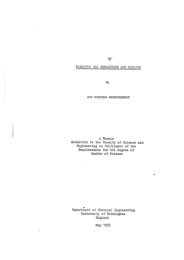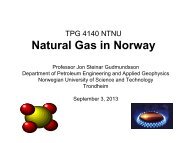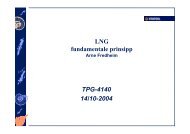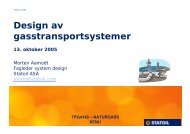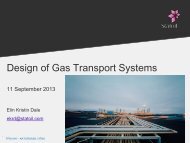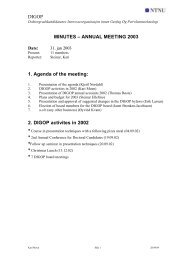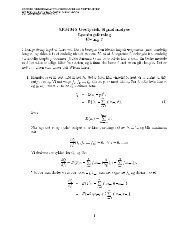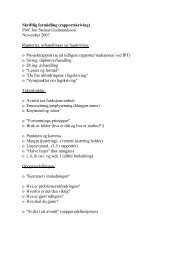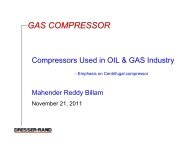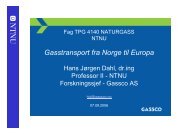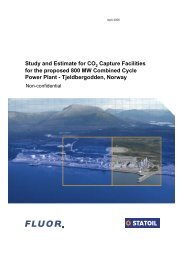Ormen Lange Utbyggingen - NTNU
Ormen Lange Utbyggingen - NTNU
Ormen Lange Utbyggingen - NTNU
Create successful ePaper yourself
Turn your PDF publications into a flip-book with our unique Google optimized e-Paper software.
Faculty of Engineering Science and Technology<br />
Department of Petroleum Engineering and Applied Geophysics<br />
DEPOSITS DETECTION USING PRESSURE PULSE TECHNOLOGY<br />
<strong>Ormen</strong> <strong>Lange</strong> Pipelines Case Study Using Process Simulation Tools<br />
Karl Ludvig Heskestad<br />
Trondheim, December 2004
Preface<br />
This project work has been done in connection with my in-depth study of petroleum<br />
production at <strong>NTNU</strong>, Trondheim. The work was carried out from September to<br />
December 2004.<br />
I would like to thank Professor Jón Steinar Gudmundsson, of the Department of<br />
Petroleum Engineering and Applied Geophysics at <strong>NTNU</strong>, and Jon Rønnevig of<br />
Markland AS, who has been very helpful and cooperative.<br />
Deposits Detection Using Pressure Pulse Technology<br />
<strong>Ormen</strong> <strong>Lange</strong> Pipelines Case Study Using Process Simulation Tools<br />
ii
Abstract<br />
The subject of this work is a presentation of deposits detection on the <strong>Ormen</strong> <strong>Lange</strong><br />
multiphase pipelines, using pressure pulse technology. The work has been conducted<br />
with the use of the process simulation tool, HYSYS. Special attention is paid to<br />
comparison of full and highly reduced multiphase production on the <strong>Ormen</strong> <strong>Lange</strong> field.<br />
A simulation process that is similar to the <strong>Ormen</strong> <strong>Lange</strong> field has been accounted for by<br />
the use of real data. The results from simulation without deposits have been checked by<br />
analytical methods. Deposits of 10, 50 and 100 millimetres thick, 100 and 1000 metres<br />
long have subject to investigation. As a quality check, simulations have also been<br />
performed by expert Jon Rønnevig at Markland AS. Pressure pulse is introduced as a<br />
deposit detection and leakage detection method. Discussion of the results obtained have<br />
been performed with emphasize on the pressure pulse technology.<br />
Deposits Detection Using Pressure Pulse Technology<br />
<strong>Ormen</strong> <strong>Lange</strong> Pipelines Case Study Using Process Simulation Tools<br />
iii
Table of Contents<br />
Preface................................................................................................................................. ii<br />
Abstract..............................................................................................................................iii<br />
Table of Contents............................................................................................................... iv<br />
Table list.............................................................................................................................. v<br />
Figure list ............................................................................................................................ v<br />
1 Introduction................................................................................................................. 1<br />
2 <strong>Ormen</strong> <strong>Lange</strong> .............................................................................................................. 2<br />
2.1 Subsea development............................................................................................ 2<br />
2.2 Pipelines.............................................................................................................. 3<br />
3 Pressure pulse technology........................................................................................... 5<br />
3.1 Principle of pressure pulse.................................................................................. 5<br />
3.2 Pressure pulse detection ability range................................................................. 7<br />
3.3 Pressure pulse applications ................................................................................. 8<br />
4 Simulation program HYSYS .................................................................................... 10<br />
4.1 Basis environment............................................................................................. 10<br />
4.2 Simulation environment.................................................................................... 10<br />
4.3 Objects .............................................................................................................. 11<br />
5 Simulation of production without deposits............................................................... 12<br />
5.1 Reservoir gas saturated with water ................................................................... 12<br />
5.2 Production wells................................................................................................ 12<br />
5.3 Multiphase pipeline........................................................................................... 13<br />
5.4 Flow assurance.................................................................................................. 13<br />
6 Simulation with deposits in the pipeline................................................................... 15<br />
6.1 Sound velocity .................................................................................................. 15<br />
6.2 Deposit detection .............................................................................................. 15<br />
6.3 Results............................................................................................................... 16<br />
6.4 Discussion......................................................................................................... 17<br />
6.5 Conclusion ........................................................................................................ 18<br />
7 References................................................................................................................. 19<br />
8 Tables........................................................................................................................ 21<br />
9 Figures....................................................................................................................... 26<br />
A. Calculations............................................................................................................... 36<br />
a. Temperature Calculations ..................................................................................... 36<br />
b. Water amount........................................................................................................ 37<br />
c. Pressure pulse........................................................................................................ 38<br />
Deposits Detection Using Pressure Pulse Technology<br />
<strong>Ormen</strong> <strong>Lange</strong> Pipelines Case Study Using Process Simulation Tools<br />
iv
Table list<br />
Table 1 Overview of pipeline specifications [5]............................................................... 21<br />
Table 2 Pipelines corrosion coating summary [5] ............................................................ 22<br />
Table 3 Gas composition [6]............................................................................................. 22<br />
Table 4 Wellstream composition ...................................................................................... 23<br />
Table 5 Flow regime in the production wells ................................................................... 24<br />
Table 6 Flow regime of the multiphase pipeline .............................................................. 25<br />
Figure list<br />
Figure 1 Graphical view of the elevation profile for one of the 9 5/8’’ wells [6] ............ 26<br />
Figure 2 The <strong>Ormen</strong> <strong>Lange</strong> subsea compression pilot project: “Subsea Sputnik” [3] ..... 26<br />
Figure 3 Graphical view of Water-hammer and Line-packing [7] ................................... 27<br />
Figure 4 Pipeline diameter reduced in the interval A-B [7].............................................. 27<br />
Figure 5 Friction increased in interval C-D [7] ................................................................ 28<br />
Figure 6 Shows the basis environment in HYSYS [12] ................................................... 28<br />
Figure 7 Shows how the reservoir gas is created in HYSYS [12].................................... 29<br />
Figure 8 Shows how the temperature changes in the production wells............................ 29<br />
Figure 9 Shows the pressure drop in the 9 5 / 8 ’’ wells....................................................... 30<br />
Figure 10 is a graphical display of the elevation profile to the multiphase pipeline [13].30<br />
Figure 11 Shows how the temperature changes in the multiphase pipeline ..................... 31<br />
Figure 12 Displays how the pressure changes in the multiphase pipeline........................ 31<br />
Figure 13 Water content of hydrocarbon gas [17]............................................................ 32<br />
Figure 14 Shows the hydrate area of the multiphase pipeline without MEG injection .... 33<br />
Figure 15 Sound velocity for case one, full production [14] ............................................ 34<br />
Figure 16 Sound velocity for case two, reduced production [14]..................................... 34<br />
Figure 17 Pressure pulse at full production ...................................................................... 35<br />
Figure 18 Pressure pulse with reduced flow..................................................................... 35<br />
Deposits Detection Using Pressure Pulse Technology<br />
<strong>Ormen</strong> <strong>Lange</strong> Pipelines Case Study Using Process Simulation Tools<br />
v
1 Introduction<br />
Detection of deposits in subsea multiphase pipelines is a very important issue for the<br />
petroleum industry. As more and more of the fields offshore are developed subsea, it is<br />
important to develop reliable and precise methods to detect deposits in the pipelines<br />
which often are multiphase.<br />
The <strong>Ormen</strong> <strong>Lange</strong> field which is under development is planned to have two multiphase<br />
pipelines each of 120 kilometres long. It is necessary to monitor and detect possible<br />
deposits in the pipelines. Pressure pulse technology, PressurePulse TM , is patented by<br />
Markland AS and has been used with success on several fields in the North Sea to detect<br />
deposits.<br />
In this work a simplified model of the <strong>Ormen</strong> <strong>Lange</strong> field has been built in HYSYS, data<br />
and values have been extracted to perform necessary calculations of pressure pulse to<br />
verify whether pressure pulse technology can be applied as detection method.<br />
In this project assignment the challenge has been to detect deposits in the multiphase<br />
pipelines on the <strong>Ormen</strong> <strong>Lange</strong> field, using pressure pulse technology. The process<br />
simulation tool, HYSYS, has been applied.<br />
Deposits Detection Using Pressure Pulse Technology<br />
<strong>Ormen</strong> <strong>Lange</strong> Pipelines Case Study Using Process Simulation Tools<br />
1
2 <strong>Ormen</strong> <strong>Lange</strong><br />
The <strong>Ormen</strong> <strong>Lange</strong> field is located in the Norwegian Sea, approximately 100 kilometres<br />
northwest of the coast of Møre. With its 400 billion Sm 3 of gas, its Norway’s largest gas<br />
field and it was discovered by Norsk Hydro in 1997. Production will begin in the 3 rd<br />
quarter of 2007 and when the field reaches its maximum production, it will have the<br />
capacity to deliver 20 % of Great Britain’s need for natural gas [1].<br />
The reservoir is very characteristic. It covers an area of 10 by 44 kilometres; the depth of<br />
the reservoir varies between 2650 metres and 2915 metres beneath mean sea level. Initial<br />
reservoir pressure is about 290 bara and the temperature ranges from 86 to 96 ºC. The<br />
field is located within a prehistoric slide area, the Storegga slide, with water depths<br />
varying from 850 to 1100 metres in the planned development area. The Storegga slide is<br />
extremely irregular with soil conditions varying from very stiff clay with boulders to soft<br />
clay [2]. The Storegga slide has been thoroughly researched to find out whether such a<br />
slide could occur again, and the conclusion is that it requires a new ice-age [3].<br />
2.1 Subsea development<br />
Every installation on the <strong>Ormen</strong> <strong>Lange</strong> field is thought to be subsea. Initial development<br />
will consist of two 8-slot production templates (A & B), with approximately 4 kilometres<br />
between them [2]. Each template will have four 9 5 / 8 ’’ and four 7’’ wells [3]. The 9 5 / 8 ’’<br />
well will have a production capacity of 10 MSm 3 /d and the 7’’ will have a capacity of 6.4<br />
MSm 3 /d [4]. A well trajectory to one of the 9 5 / 8 ’’ wells is shown in Figure 1.<br />
Each of the production templates will have a 20’’ production header which will be tied<br />
into the two 30’’ multiphase pipelines by rigid spools. The two 30’’ lines will be<br />
connected via a pipeline end termination system (PLET). Two main control umbilicals<br />
will link the onshore plant to the subsea production system; one will be connected to<br />
template A and the other to template B. For redundancy there will be a cross over control<br />
umbilical that’ll interconnect the two templates and also a pigging loop will be installed<br />
Deposits Detection Using Pressure Pulse Technology<br />
<strong>Ormen</strong> <strong>Lange</strong> Pipelines Case Study Using Process Simulation Tools<br />
2
to secure the capability of round-trip pigging of the two 30’’ multiphase lines. To prevent<br />
hydrate formation, all wells are continuously dosed with monoethylene glycol (MEG),<br />
supplied via two 6’’ pipelines from the shore terminal, Nyhamna. They are connected in<br />
the same manner as the umbilicals and they also have a crossover interconnection [2].<br />
A further development might be necessary depending on the production experience. One<br />
of the uncertainties is how many and if there is communication between the faults in<br />
<strong>Ormen</strong> <strong>Lange</strong> [3]. If more wells are required, one scenario is to add two 6-slot production<br />
templates (C & D). They will include two spare well slots that may be used for additional<br />
wells. Each of these production templates will produce gas through dual 12’’ manifold<br />
headers and infield flowlines tied back to the 30’’ PLET (valid for template C) and hottap<br />
tees in the 30’’ lines (valid for template D). A new infield 6’’ MEG line will be<br />
connected to each of the two future templates as extensions from the initial templates.<br />
The remaining well completions are assumed to be 7’’ wells [2]. In the future it will be<br />
necessary to compress the gas, to increase the pressure. A pre-compression platform or a<br />
subsea compression unit, see Figure 2, is one of the possibilities considered by Norsk<br />
Hydro [3].<br />
2.2 Pipelines<br />
There are initially four pipelines which have to be laid to connect Nyhamna to the <strong>Ormen</strong><br />
<strong>Lange</strong> field; two multiphase lines and two MEG lines.<br />
As a base case, two multiphase pipelines with constant ID of 690 millimetres will be<br />
installed from the land terminal at Nyhamna to the field. These lines will be called<br />
Production Line A (PL-A) and Production Line B (PL-B). The governing design criteria<br />
for the 30’’ pipelines depends on the water depth, location class and on the design<br />
temperature, Table 1 shows the selected wall thickness. To achieve stability of the<br />
pipelines, weight coating and additional intervention work is needed. The weight coating<br />
is mainly governed by the need for lateral stability in the operational phase [5].<br />
Deposits Detection Using Pressure Pulse Technology<br />
<strong>Ormen</strong> <strong>Lange</strong> Pipelines Case Study Using Process Simulation Tools<br />
3
The 6’’ MEG pipelines will be installed from the land terminal at Nyhamna to each of the<br />
templates A and B. As for the multiphase pipelines the governing design criteria depends<br />
on the water depth and location class. Current calculations of lateral stability for the<br />
MEG pipelines during the installation show that the MEG line is partly unstable. Further<br />
engineering work will be undertaken to further evaluate the stability. However for the<br />
operational phase, the pipelines are fully protected by trenching or rock dumping [5].<br />
To protect the pipelines from external corrosion, a combination of corrosion coating and<br />
sacrificial anodes will be applied. See Table 2 for full description. The first 33 kilometres<br />
of the multiphase pipelines will be installed from Nyhamna and out of the near shore<br />
area, Bjørnesundet, in 2005. The remaining part will be installed in 2006 together with<br />
the two main MEG pipelines. Since the templates (A & B) are located with<br />
approximately 4 kilometres apart, it allows for rig work, even with anchors, to be done at<br />
one template while marine activities can take place at the other. Base case is to install the<br />
multiphase pipelines by use of both S-lay and J-lay methods. For the MEG lines a reel<br />
vessel will be used, alternatively an S-lay or J-lay vessel can be used [5].<br />
Deposits Detection Using Pressure Pulse Technology<br />
<strong>Ormen</strong> <strong>Lange</strong> Pipelines Case Study Using Process Simulation Tools<br />
4
3 Pressure pulse technology<br />
Since the early 1990’s the pressure pulse technology has been developed, with basic<br />
research at the Norwegian University of Science and Technology (<strong>NTNU</strong>), further<br />
improvement and commercializing has been done by Markland TM . Extensive field testing<br />
on several production platforms, has demonstrated the feasibility of pressure pulse<br />
technology for allocation testing and wellbore monitoring [7].<br />
3.1 Principle of pressure pulse<br />
The pressure pulse is obtained from pressure measurements at one location, immediately<br />
up-stream of a quick-acting valve [7]. The pressure pulse method is based on the<br />
combined effects of the water-hammer measured in a gas-liquid flow when a valve is<br />
closed quickly, the line-packing of the flow and the sound speed of the mixture in the<br />
pipeline [8].<br />
When a quick-acting valve is closed, it will generate a pressure increase up-stream of the<br />
valve; this is referred to as the water-hammer. The water-hammer is given by the<br />
Joukowsky equation:<br />
∆ pa<br />
= ρua<br />
Equation 3.1<br />
Where<br />
∆p a<br />
(Pa) is the water-hammer,<br />
ρ (kg/m 3 ) is the fluid density, u (m/s) is the<br />
homogenous fluid velocity and a (m/s) is the sound speed. To define a valve as quickacting<br />
it has to close before a pressure pulse is reflected back from up-stream or downstream.<br />
However the water-hammer is pressure increase is independent of the time it<br />
takes a quick-acting valve to close; provided it closes before any reflections arrive from<br />
up-stream or down-stream. Any reflections will affect the pressure increase during<br />
closing. An illustration of this phenomenon is shown in Figure 3. The pressure increase<br />
takes place from the valve is 80 % closed to its fully closed. Therefore most of the<br />
pressure pulse will be generated in the last 0.4 seconds if the valve’s closing time is 2.0<br />
seconds [8].<br />
Deposits Detection Using Pressure Pulse Technology<br />
<strong>Ormen</strong> <strong>Lange</strong> Pipelines Case Study Using Process Simulation Tools<br />
5
As the flow is brought to rest; line-packing occurs. The pressure up-stream will continue<br />
to increase with time, as shown in Figure 3, this pressure increase is called line-packing<br />
of the pipeline. In liquid-only flow the line-packing represents the frictional pressure drop<br />
with distance in the pipeline. The frictional pressure drop is given by the Dacy-Weisbach<br />
equation:<br />
⎛ f ⎞⎛L⎞<br />
∆ p<br />
f<br />
= ⎜ ⎟⎜ ⎟ u<br />
⎝ 2 ⎠⎝d<br />
⎠<br />
ρ<br />
2<br />
Equation 3.2<br />
Where f (-) is the friction factor, L (m) the length of the pipeline and d is the diameter of<br />
the pipe, the other variables are given above. Line-packing is more complicated in gasliquid<br />
flow, due to its increase in water-hammer with up-stream distance [8].<br />
The sound speed is the third effect in the pressure pulse technology. The sound speed in<br />
gas-liquid mixtures is much lower than the sound speed in single-phased flows [8].<br />
Experiments shows that the sound speed for void fraction in the range 0.2 – 0.8 was in<br />
the range of 30 – 40 m/s for line pressure in the range of 1.4 – 1.6 bara. It was also shown<br />
that a homogenous sound speed model gave a good match with the experimental result<br />
[9].<br />
The sonic velocity in gas-liquid mixtures is given by the Wood equation:<br />
G<br />
1<br />
a = Equation 3.3<br />
A ⋅ B<br />
( 1 )<br />
A = αρ + −α<br />
ρ Equation 3.4<br />
⎛ α ⎞ ⎛1−α<br />
⎞<br />
Equation 3.5<br />
B = ⎜ 2 ⎟+<br />
⎜ 2 ⎟<br />
⎝ρGaG ⎠ ⎝ρLaL<br />
⎠<br />
Where α (-) is the void fraction, and the subscripts G and L denotes gas and liquid<br />
respectively. In 1993 a computer program developed by Dong and Gudmundsson was<br />
used to estimate the speed of sound in the gas-oil mixture flowing at 60 bar and 90 bar in<br />
an offshore well on the Gullfaks B platform. The wellhead pressure was approximately<br />
90 bars and the separator pressure about 60 bars. For two-phase mixtures the computer<br />
program gives the same result as Equation 3.3. Experiments show that the speed of sound<br />
L<br />
Deposits Detection Using Pressure Pulse Technology<br />
<strong>Ormen</strong> <strong>Lange</strong> Pipelines Case Study Using Process Simulation Tools<br />
6
in pure liquids is high, but decreases dramatically with small amounts of gas. When the<br />
void fraction is in the range of 0.2 – 0.8 the sound speed remains relatively constant, but<br />
from 0.8 and to pure gas, the sound speed increases along with the pressure [8].<br />
For any single phase fluid, gas or liquid the expression for sound speed is:<br />
c<br />
2<br />
∂p<br />
∂p<br />
= = γ<br />
∂ρ<br />
∂ρ<br />
S<br />
T<br />
Equation 3.6<br />
The subscript S and T denotes isentropic and isothermal processes, and γ the ratio of<br />
specific heats. An expression for sonic velocity in multiphase mixtures has been<br />
developed by Dong and Gudmundsson which relates the sonic velocity of the mixture<br />
directly to the properties of the gases and liquids. Equation 3.6 can be rewritten by the<br />
use of isentropic, K S , or isothermal, K T , compressibility.<br />
Or<br />
c<br />
c<br />
γ<br />
= =<br />
= Equation 3.7<br />
S<br />
ρ Κ<br />
2 1<br />
C<br />
2 p<br />
T<br />
T<br />
ρK CvρK<br />
Equation 3.8<br />
Where the superscripts S and T refer to an isothermal and isentropic process respectively,<br />
C p is isobaric specific heat and C v isochoric specific heat. As seen from Equation 3.8, the<br />
sonic velocity of any fluid or mixture can be related directly to its density, isothermal<br />
compressibility and specific heat. For a multiphase mixture these properties are functions<br />
of those of its constituent fluids. Therefore, its sonic velocity can be directly related to<br />
those of its pure constituents. Knowing those properties gives an opportunity to calculate<br />
the sonic velocity arithmetically instead of differentially [10].<br />
3.2 Pressure pulse detection ability range<br />
Pressure pulse detection ability range is calculated from Equation 3.9. This equation is<br />
obtained by comparison of ∆p a = ∆p f .<br />
ρ L<br />
max 2<br />
ρ ua = f u<br />
Equation 3.9<br />
2 di<br />
If Equation 3.9 is rearranged with respect to L max , it gives the expression to Equation 3.10<br />
Deposits Detection Using Pressure Pulse Technology<br />
<strong>Ormen</strong> <strong>Lange</strong> Pipelines Case Study Using Process Simulation Tools<br />
7
L<br />
max<br />
=<br />
2⋅<br />
a⋅<br />
di<br />
f ⋅u<br />
Equation 3.10<br />
Where L max denotes the pressure pulse detection ability, d i is the internal diameter; the<br />
other variables are given earlier [11].<br />
3.3 Pressure pulse applications<br />
The pressure pulse technology is versatile and can be applied in many areas, and in the<br />
petroleum industry it can be applied in pipelines, flow lines and wellbores.<br />
Pressure pulse technology can be used to detect and monitor solid deposits. To illustrate<br />
how pressure pulse can be used to detect a reduction in diameter, see Figure 4. The<br />
diameter reduction is abrupt and significant and exists for some distance, until the<br />
diameter expands abruptly back to its original diameter. The pressure pulse goes back to<br />
its original gradient because of the pressure pulse that travels the opposite way and has<br />
the same value, only negative. The point A represents the distance from the quick-acting<br />
valve to the reduction in pipeline diameter, and the point B represents the distance from<br />
the valve to the resumption of full pipeline diameter. Such a reduction in pipeline<br />
diameter which occurs in the interval AB could originate from the deposition of solids in<br />
the particular interval.<br />
An increase in friction factor will result in similar effects as a decrease in diameter, as<br />
evident from Equation 3.2. The increase in friction factor increases the frictional pressure<br />
gradient in the interval, as illustrated in Figure 5. The point C represents the distance<br />
from the quick acting-valve where friction increases, and the point D represents the<br />
distance from the valve where pipeline friction decreases. A complicating factor is that<br />
when the internal diameter is reduced from the depositions of solids, it may also be<br />
accompanied by a change in friction factor [7].<br />
When detection ability range has been determined for the pressure pulse, it is possible to<br />
detect leaks within this range. When leak occurs in the pipeline, some of the fluid<br />
escapes. When steady-state is achieved, a leak will result in a change in mass flow rate<br />
Deposits Detection Using Pressure Pulse Technology<br />
<strong>Ormen</strong> <strong>Lange</strong> Pipelines Case Study Using Process Simulation Tools<br />
8
and greater pressure drop in the pipeline. By applying pressure pulse technology it will be<br />
possible to detect where the leak is located [11].<br />
Deposits Detection Using Pressure Pulse Technology<br />
<strong>Ormen</strong> <strong>Lange</strong> Pipelines Case Study Using Process Simulation Tools<br />
9
4 Simulation program HYSYS<br />
The process simulation program HYSYS is attributed Hyprotech, a subsidiary of Aspen<br />
Technology. The usability of the program is attributed to the following four key aspects<br />
of its design:<br />
• Event driven operation<br />
• Modular operations<br />
• Multi-flowsheet Architecture<br />
• Object oriented design<br />
4.1 Basis environment<br />
The basis environment contains the following environments:<br />
• Simulation Basis Environment<br />
• Oil Characterization Environment<br />
When beginning a new simulation case, HYSYS automatically starts the program in the<br />
Simulation Basis environment where one can create, define and modify fluid packages<br />
for use by the simulation flowsheets. In general a fluid package contains a minimum of<br />
one property package and library and/or hypothetical components. Fluid packages can<br />
also contain information for reactions and interactions parameters. The oil<br />
characterization environment enables you to characterize petroleum fluids by creating<br />
and defining Assay and Blends, see Figure 6. This attribute has not been used in this<br />
project [12].<br />
4.2 Simulation environment<br />
The simulation environment contains the main flowsheet where the majority of the work,<br />
such as installing and defining streams, unit operations, columns and sub-flowsheets.<br />
This flowsheet serves as the base level or “main” flowsheet for the whole simulation<br />
case. Any number of sub-flowsheets can be generated from the main flowsheet, but there<br />
is only one main flowsheet environment. Each individual sub-flowsheet that is installed<br />
has its own corresponding sub-flowsheet environment; in Figure 7 the simulation<br />
environment is shown [12].<br />
Deposits Detection Using Pressure Pulse Technology<br />
<strong>Ormen</strong> <strong>Lange</strong> Pipelines Case Study Using Process Simulation Tools<br />
10
4.3 Objects<br />
Objects are used to build your simulation within the Simulation environment. The objects<br />
in HYSYS are streams, unit operations or logical operations. To install objects in the<br />
simulation, use of the Object Palette is required. In the Object Palette it’s possible to<br />
choose from these categories:<br />
• Streams<br />
• Vessels (2- and 3-phase separators, tank)<br />
• Heat transfer equipment<br />
• Rotating equipment (compressor, expander, pump)<br />
• Piping equipment<br />
• Solids handling<br />
• Reactors<br />
• Pre-built columns<br />
• Shortcut columns<br />
• Sub-flowsheets<br />
• Logicals<br />
[12]<br />
Deposits Detection Using Pressure Pulse Technology<br />
<strong>Ormen</strong> <strong>Lange</strong> Pipelines Case Study Using Process Simulation Tools<br />
11
5 Simulation of production without deposits<br />
In the simulation program HYSYS, a simplified flowsheet of the <strong>Ormen</strong> <strong>Lange</strong> has been<br />
created. The simulation objects consist of four 9 5 / 8 ’’ completed wells, one of the two<br />
30’’ multiphase pipelines and a separator at the end. As a base case the simulations have<br />
been done without any deposits, to verify that the system behaves similar to Norsk<br />
Hydro’s description.<br />
5.1 Reservoir gas saturated with water<br />
The reservoir gas consists of 16 different components, see Table 3, this gas should be<br />
saturated with water. To create the desired wellstream in HYSYS, the gas stream is<br />
brought together with a water stream into a separator. From the separator two new<br />
streams emerge, vapour and liquid outlet. The vapour outlet becomes the wellstream, and<br />
the liquid outlet is not being used any further, see Figure 7 for details. The wellstream is a<br />
gas saturated with water; its composition is given in Table 4.<br />
5.2 Production wells<br />
Each 9 5 / 8 ’’ completed well is supposed to have a capacity of 10 MSm 3 /d of flow<br />
according to Norsk Hydro. In the simulation done in this project, the four wells have<br />
produced approximately 8.7 MSm 3 /d, which is equivalent to 81 kg/s. For simplicity all<br />
the four wells have the same elevation profile [6], the elevation profile is shown in Figure<br />
1. As mentioned the outer diameter is 9 5 / 8 ’’, the internal diameter has been set to 8 1 / 2 ’’.<br />
The formation temperature has been calculated from Equation 5.1:<br />
T<br />
amb<br />
dΤ<br />
= Lint<br />
erval<br />
⋅ Equation 5.1<br />
dL<br />
Where T amb is the ambient temperature, L interval is the vertical length of the interval in the<br />
∂<br />
formation and T ∂L<br />
is the temperature gradient for the formation which has been set to<br />
48.3 C / km [16]. The heat transfer coefficient (HTC) for the well has been set to 4 W / m<br />
2<br />
ºC<br />
[16]. The reservoir temperature in the simulations is 96ºC, the calculated temperature at<br />
the top (sea bottom) is -1.2ºC, see Appendix A. When the surrounding temperature and<br />
reservoir is given as input HYSYS calculates that the wellflow has a temperature of<br />
Deposits Detection Using Pressure Pulse Technology<br />
<strong>Ormen</strong> <strong>Lange</strong> Pipelines Case Study Using Process Simulation Tools<br />
12
approximately 80ºC, see Figure 8. The pressure in the reservoir initially is 290 bars, this<br />
drop to 218 bars at the wellhead, due to the high flow, as showed in Figure 9.<br />
5.3 Multiphase pipeline<br />
In the simulation; only one of the two multiphase pipelines has been simulated. The<br />
pipeline’s outer diameter is, as mentioned earlier, 30’’ and its inner diameter is 27.17’’<br />
(690mm). The two pipelines together are supposed to have a production of 70 MSm 3 /d.<br />
The pipeline is 121 kilometres long and the elevation profile is given in Figure 10. An<br />
overall HTC has been decided and set to 11 W 2<br />
/ m ºC [16], and the seawater temperature to<br />
2.5ºC [16]. The inlet temperature is 80ºC, from Equation 5.2 the outlet temperature is<br />
calculated to be 7.0ºC., see appendix A.<br />
⎡−Uπ<br />
d ⎤<br />
T2 = T + ( T1−T)exp⎢ L⎥<br />
⎢⎣<br />
mC<br />
p ⎥⎦<br />
Equation 5.2<br />
Where U is the overall HTC, m is the massflow, C p is the specific heat capacity, T, T 1<br />
and T 2 is the surrounding-, inlet- and outlet temperature respectively. The HYSYS<br />
simulation gives an outlet temperature of 3.8ºC which is close to the value expected by<br />
the analytical calculations, see Figure 11. The difference in temperatures is probably due<br />
to the expansion of the gas, which has been neglected in Equation 5.2. The total pressure<br />
loss in the pipeline is approximately 55 bars; this is shown in Figure 12.<br />
5.4 Flow assurance<br />
Several aspects of the flow had to be checked to verify that it was consistent with Norsk<br />
Hydro’s information.<br />
Water production is expected from the <strong>Ormen</strong> <strong>Lange</strong> field. The water-saturated gas<br />
should, according to the graph shown in Figure 13, contain approximately 3500 mg water /<br />
Sm3 of wet gas, result taken from the separator at the end of the multiphase pipeline, and basic<br />
calculations, see appendix A, show that amount of water is correct, this is also the amount<br />
of condensated water Norsk Hydro operates with. In this simulation, it has been assumed<br />
for simplicity to ignore the free water that is flowing in the reservoir; this should not have<br />
any considerable effect on the results [16].<br />
Deposits Detection Using Pressure Pulse Technology<br />
<strong>Ormen</strong> <strong>Lange</strong> Pipelines Case Study Using Process Simulation Tools<br />
13
The HTFS Homogenous Flow [16] has been selected as the pipe multiphase flow<br />
correlation in HYSYS, both in the wells and the multiphase pipeline. From pvt-data<br />
generated by HYSYS, it shows that there is two-phase flow after the first 100 metres of<br />
the well(s) and through-out the whole system, see Table 5 and Table 6.<br />
Pressure losses associated with wellheads, valves and manifold have been ignored in the<br />
simulation. However this simulation has only implemented four wells, connected to the<br />
template, Norsk Hydro is planning to have seven wells on each template. Since the<br />
production in the simulation is just as high as the planned production, this will give a<br />
total pressure loss that probably is higher than what the pressure loss will be when<br />
production starts with seven wells at each template.<br />
The multiphase pipelines are expected to form hydrates; obviously the production wells<br />
are not in the hydrate area. From the HYSYS simulation, it shows that after the first 50<br />
kilometres the pipeline enters the hydrate formation area, without MEG injection; see<br />
Figure 14. The hydrate area in the simulation is probably a bit larger than what it is<br />
supposed to be, due to a lower inlet pressure to the multiphase pipeline in the simulation<br />
compared to real conditions. Norsk Hydro is planning to inject a substantial amount of<br />
MEG to avoid hydrates.<br />
Deposits Detection Using Pressure Pulse Technology<br />
<strong>Ormen</strong> <strong>Lange</strong> Pipelines Case Study Using Process Simulation Tools<br />
14
6 Simulation with deposits in the pipeline<br />
The simulation has been performed with deposits in the pipeline, compared two cases;<br />
one with production flow and one where the flow has been reduced to 1 / 10 of the original<br />
flow. Pressure curves have been extracted from HYSYS and sound velocity calculated.<br />
All the data that has been acquired in HYSYS have been extracted to Excel for further<br />
calculations.<br />
To simulate deposits, a narrowing is created in the multiphase pipeline. Different deposit<br />
sizes have been tested; 10 mm and 50 mm. The deposits have been placed in the<br />
beginning of the hydrate area; this is without MEG injection, more exactly after 56<br />
kilometres. This is based on the pressure and temperature equilibrium curve, and the<br />
hydrate area is for a pipe in production.<br />
Simulation of these cases has also been done at Markland, by expert Jon Rønnevig. The<br />
pressure pulse was calculated with the custom designed program, PPsim TM .<br />
6.1 Sound velocity<br />
The sound velocities calculations have been done with a simulation program called<br />
PPSound TM [14], for the two cases; production flow and reduced flow. The previously<br />
described model in chapter 3.1, has been tested, as mentioned it doesn’t give the correct<br />
results at given places in the pipeline, however the mean sound velocity is quite close to<br />
the real mean sound velocity, sadly the mean velocity isn’t very applicable for these<br />
calculations. The results from the calculations are shown in Figure 15 and Figure 16.<br />
6.2 Deposit detection<br />
Detecting deposits is based on the pressure pulse that is generated when the quick-acting<br />
valve is closed. Two conditions decide if the operation will be a success or not; the size<br />
of the pressure pulse and how fast the pressure pulse dies out. According to Equation<br />
3.10 it is possible to calculate the distance the pressure pulse is capable of travelling. To<br />
acquire information with regards to friction, pressure and so on, it is necessary that the<br />
Deposits Detection Using Pressure Pulse Technology<br />
<strong>Ormen</strong> <strong>Lange</strong> Pipelines Case Study Using Process Simulation Tools<br />
15
pressure pulse can travel at least as far as to the areas where deposits will most likely<br />
develop; preferably throughout the whole pipe.<br />
If the pressure pulse is capable of travelling the desired distance, the data the pressure<br />
pulse obtains can be used to detect deposits. When sound velocity has been calculated<br />
along the pipe it is possible to calculate the change in pressure vs. time, by creating a plot<br />
comparing the pressure pulses from pipe with and without deposits the deposits will<br />
result in an extra change in pressure starting where the deposits are, see Figure 17, the<br />
derivative curve makes it easier to spot the deposit.<br />
6.3 Results<br />
As mentioned, two cases, and two different deposit sizes have been tested, the<br />
calculations have taken into account that they are performed from the land facility,<br />
Nyhamna.<br />
At full production, case one, the pressure pulse is relatively high, 3.84 bars, but the<br />
pressure loss due to friction is even higher and it is not possible to detect deposits any<br />
further than 12 to 13 kilometres from land (Nyhamna), see Figure 17. By looking at the<br />
derivative curve it is easy to see where the pressure pulse dies out. This distance is close<br />
to what is expected by using Equation 3.10. Considering that the hydrate area starts after<br />
approximately 50 kilometres (without MEG injection) from the wellheads it makes<br />
detection of deposits from land quite hopeless.<br />
Case two where the production is 1 / 10 of the original, the pressure pulse is only 0.46 bars<br />
but due to less flow, the pressure loss due to friction is very low and the pressure pulse<br />
travels throughout the whole pipeline. Deposits are detected by the pressure pulse at 56<br />
kilometres from the wellheads, see Figure 18. The sizes on the deposits affects case one<br />
more than case two, assuming that the pressure pulse reaches the deposit in case one. It is<br />
easily shown when examining the derivative curves in the figures located in Appendix A.<br />
Deposits Detection Using Pressure Pulse Technology<br />
<strong>Ormen</strong> <strong>Lange</strong> Pipelines Case Study Using Process Simulation Tools<br />
16
Results from the Markland simulation confirm the results to some degree. However it<br />
shows that a deposition of only 100 metres long and 10 millimetres thick would be<br />
difficult to discover, even at a 1 / 10 of the original rate, this due to disturbing factors that<br />
might reduce the signal. Simulation performed with deposition with a length of 1000<br />
metres is detected by the pressure pulse, at the same rate.<br />
6.4 Discussion<br />
The pressure pulse technology is a clever and easy technology to use. However it has its<br />
limitations especially that it is not applicable to detect deposits longer than 12 kilometres<br />
from land during full production; solutions to this problem exists. The technology is also<br />
very dependent on having correct data on the examining pipes in “perfect” state; clean<br />
pipe.<br />
One solution could be to install two or three quick-acting valves on each of the<br />
multiphase pipelines. This would create a pipeline system that would have the ability to<br />
detect deposits easily.<br />
Another solution is to reduce the flow to increase the distance the pressure pulse can<br />
travel. This should be possible since the <strong>Ormen</strong> <strong>Lange</strong> will have two multiphase<br />
pipelines, one of the pipelines can produce at full capacity while the other is reduced for<br />
maintenance. However the pressure pulse generated at highly reduced flow is quite small<br />
and could be difficult to measure, considering that there are many disturbing factors in<br />
the <strong>Ormen</strong> <strong>Lange</strong> pipelines. If quick-acting valves are installed on the pipelines this could<br />
be combined with a reduction in flow. A complete detection control of the entire hydrate<br />
area would then be available with a production which only is reduced by 40%.<br />
Deposits Detection Using Pressure Pulse Technology<br />
<strong>Ormen</strong> <strong>Lange</strong> Pipelines Case Study Using Process Simulation Tools<br />
17
6.5 Conclusion<br />
The use of pressure pulse technology would give the operators of the pipelines accurate<br />
information on where and how long deposits are. The technology is however dependent<br />
on a few key aspects; flow, number of quick-acting valves and historic data.<br />
To achieve results from the pressure pulse one needs to; reduce the flow significantly,<br />
install a large numbers of quick-acting valves with full production or a combination.<br />
Since the pipeline installation is in the starting phase, it should be possible to install<br />
quick-acting valves. If the pressure pulse technology is implemented at the start of the<br />
<strong>Ormen</strong> <strong>Lange</strong> project, one will have the possibility to gather data on how the pipeline acts<br />
when the flow is “perfect”. The comparison of measured data with data for a clean pipe is<br />
crucial for the pressure pulse technology, but if this is available then the technology<br />
works very well.<br />
The best solution is most likely a combination of the alternatives. The installation of three<br />
quick-acting valves and a reduction of 40 % in flow will give a full monitoring of<br />
deposits in the multiphase pipelines.<br />
Deposits Detection Using Pressure Pulse Technology<br />
<strong>Ormen</strong> <strong>Lange</strong> Pipelines Case Study Using Process Simulation Tools<br />
18
7 References<br />
[1] Norsk Hydro’s web pages<br />
http://www.ormenlange.com/no/about_ormen/index.html<br />
[2] Arild Wilson, Sverre J Overaa, Henning Holm/Norsk Hydro ASA, Norway<br />
”<strong>Ormen</strong> <strong>Lange</strong> – Flow Assurance Challenges,” OTC 16555, 2004<br />
[3] Leif Huse Jensen, Norsk Hydro ASA<br />
“<strong>Ormen</strong> <strong>Lange</strong> og <strong>Lange</strong>led”, Presentation at <strong>NTNU</strong>, 30 th of September 2004<br />
[4] Robin A. Hartman, Gerd Olaug Vikeså, A/S Norske Shell, Per A. Kjærnes, Norsk<br />
Hydro ASA<br />
“Big Bore, High flowrate, deep water gas wells for <strong>Ormen</strong> <strong>Lange</strong>” OTC 16554, 2004.<br />
[5] Anders Henriksson, Asbjørn Wilhelmsen, Tore Karlsen, Norsk Hydro ASA<br />
”Pipelines in harsh environment” OTC 16557, 2004<br />
[6] E&P Norsk Hydro ”<strong>Ormen</strong> <strong>Lange</strong> Project”<br />
Internal report no.: 37-00-NH-X02-00001, 2001<br />
[7] Jon S. Gudmundsson, Ismail Durgut, <strong>NTNU</strong>, Harlald K. Celius, Kjell Korsan,<br />
Markland AS<br />
“Detection and monitoring of deposits in multiphase flow pipelines using pressure<br />
pulse technology,” 2001<br />
[8] Jon S. Gudmundsson, <strong>NTNU</strong>/SPE Trondheim, Harald K. Celius, Markland AS/SPE<br />
Trondheim<br />
“Gas-Liquid Metering Using Pressure-Pulse Technology” SPE 56584, 1999.<br />
[9] Jon S. Gudmundsson, L. Dong and F. Rødøy<br />
“Two-phase Flow Metering by Pressure Pulse Propagation” SPE 24778, 1992<br />
[10] Jon S. Gudmundsson, and L. Dong<br />
“Model for Sound Speed in Multiphase Mixtures”, 1993<br />
[11] Sebastian Wieczorek, <strong>NTNU</strong>. Diploma Thesis<br />
“Leakage and Blockage Detection in Two-Phase Subsea Pipelines by Pressure Pulse<br />
Technology”, 2003<br />
[12] Aspentech<br />
“HYSYS 3.2 Documentation”, 2003<br />
Deposits Detection Using Pressure Pulse Technology<br />
<strong>Ormen</strong> <strong>Lange</strong> Pipelines Case Study Using Process Simulation Tools<br />
19
[13] Reinertsen, Temadag Utmatting ved <strong>NTNU</strong>, 2004<br />
”Utmatting av rørledninger på havbunnen- <strong>Ormen</strong> <strong>Lange</strong>- Ny guideline for<br />
multispenn”<br />
[14] Jon Rønnevig, Markland AS, 2004. Performed Sound Speed calculations with<br />
PPSound TM<br />
[15] Jon Rønnevig, Markland AS, 2004. Performed Pressure Pulse calculations with<br />
PPSim TM<br />
[16] Jon S. Gudmundsson, <strong>NTNU</strong>, 2004. Private communication<br />
[17] Gas Processors Association Handbook, 1980<br />
“Engineering Data Book”<br />
Deposits Detection Using Pressure Pulse Technology<br />
<strong>Ormen</strong> <strong>Lange</strong> Pipelines Case Study Using Process Simulation Tools<br />
20
8 Tables<br />
Table 1 Overview of pipeline specifications [5]<br />
Deposits Detection Using Pressure Pulse Technology<br />
<strong>Ormen</strong> <strong>Lange</strong> Pipelines Case Study Using Process Simulation Tools<br />
21
Table 2 Pipelines corrosion coating summary [5]<br />
Table 3 Gas composition [6]<br />
Component Mole Fractions<br />
Nitrogen 0,0034<br />
CO2 0,0042<br />
Methane 0,9251<br />
Ethane 0,0345<br />
Propane 0,0121<br />
i-Butane 0,0027<br />
n-Butane 0,0032<br />
i-Pentane 0,0015<br />
n-Pentane 0,0013<br />
Pseudokomp1* 0,0033<br />
Pseudokomp2* 0,0041<br />
Pseudokomp3* 0,0022<br />
Pseudokomp4* 0,0009<br />
Pseudokomp5* 0,0008<br />
Pseudokomp6* 0,0003<br />
Pseudokomp7* 0,0003<br />
Deposits Detection Using Pressure Pulse Technology<br />
<strong>Ormen</strong> <strong>Lange</strong> Pipelines Case Study Using Process Simulation Tools<br />
22
Table 4 Wellstream composition<br />
Component Mole Fractions<br />
Nitrogen<br />
3,39E-03<br />
CO2<br />
4,18E-03<br />
Methane 0,920213159<br />
Ethane<br />
3,43E-02<br />
Propane<br />
1,21E-02<br />
i-Butane<br />
2,69E-03<br />
n-Butane<br />
3,19E-03<br />
i-Pentane<br />
1,50E-03<br />
n-Pentane<br />
1,30E-03<br />
Pseudokomp1* 3,29E-03<br />
Pseudokomp2* 4,12E-03<br />
Pseudokomp3* 2,18E-03<br />
Pseudokomp4* 8,98E-04<br />
Pseudokomp5* 7,90E-04<br />
Pseudokomp6* 3,41E-04<br />
Pseudokomp7* 3,07E-04<br />
H2O<br />
5,25E-03<br />
Deposits Detection Using Pressure Pulse Technology<br />
<strong>Ormen</strong> <strong>Lange</strong> Pipelines Case Study Using Process Simulation Tools<br />
23
Table 5 Flow regime in the production wells<br />
Length [m] Flow Regime Length [m] Flow Regime<br />
0 Vapour Only 3658 Two Phase<br />
20 Vapour Only 3678 Two Phase<br />
40 Vapour Only 3698 Two Phase<br />
60 Vapour Only 3718 Two Phase<br />
80 Vapour Only 3738 Two Phase<br />
100 Two Phase 3758 Two Phase<br />
393 Two Phase 3778 Two Phase<br />
686 Two Phase 3798 Two Phase<br />
980 Two Phase 3818 Two Phase<br />
1273 Two Phase 3838 Two Phase<br />
1566 Two Phase 3858 Two Phase<br />
1859 Two Phase 3878 Two Phase<br />
2152 Two Phase 3898 Two Phase<br />
2446 Two Phase 3918 Two Phase<br />
2739 Two Phase 3938 Two Phase<br />
3032 Two Phase 3958 Two Phase<br />
3125 Two Phase 3978 Two Phase<br />
3218 Two Phase 3998 Two Phase<br />
3312 Two Phase 4018 Two Phase<br />
3405 Two Phase 4038 Two Phase<br />
3498 Two Phase 4058 Two Phase<br />
3518 Two Phase 4078 Two Phase<br />
3538 Two Phase 4098 Two Phase<br />
3558 Two Phase 4118 Two Phase<br />
3578 Two Phase 4138 Two Phase<br />
3598 Two Phase 4158 Two Phase<br />
3618 Two Phase 4178 Two Phase<br />
3638 Two Phase 4198 Two Phase<br />
Deposits Detection Using Pressure Pulse Technology<br />
<strong>Ormen</strong> <strong>Lange</strong> Pipelines Case Study Using Process Simulation Tools<br />
24
Table 6 Flow regime of the multiphase pipeline<br />
Length [m] Flow Regime Length [m] Flow Regime<br />
0 Two Phase 74700 Two Phase<br />
440 Two Phase 86600 Two Phase<br />
880 Two Phase 98500 Two Phase<br />
1320 Two Phase 98820 Two Phase<br />
1760 Two Phase 99140 Two Phase<br />
2200 Two Phase 99460 Two Phase<br />
3920 Two Phase 99780 Two Phase<br />
5640 Two Phase 100100 Two Phase<br />
7360 Two Phase 100420 Two Phase<br />
9080 Two Phase 100740 Two Phase<br />
10800 Two Phase 101060 Two Phase<br />
13620 Two Phase 101380 Two Phase<br />
16440 Two Phase 101700 Two Phase<br />
19260 Two Phase 103640 Two Phase<br />
22080 Two Phase 105580 Two Phase<br />
24900 Two Phase 107520 Two Phase<br />
27720 Two Phase 109460 Two Phase<br />
30540 Two Phase 111400 Two Phase<br />
33360 Two Phase 113340 Two Phase<br />
36180 Two Phase 115280 Two Phase<br />
39000 Two Phase 117220 Two Phase<br />
50900 Two Phase 119160 Two Phase<br />
62800 Two Phase 121100 Two Phase<br />
Deposits Detection Using Pressure Pulse Technology<br />
<strong>Ormen</strong> <strong>Lange</strong> Pipelines Case Study Using Process Simulation Tools<br />
25
9 Figures<br />
Figure 1 Graphical view of the elevation profile for one of the 9 5/8’’ wells [6]<br />
Figure 2 The <strong>Ormen</strong> <strong>Lange</strong> subsea compression pilot project: “Subsea Sputnik” [3]<br />
Deposits Detection Using Pressure Pulse Technology<br />
<strong>Ormen</strong> <strong>Lange</strong> Pipelines Case Study Using Process Simulation Tools<br />
26
10<br />
change in pressure<br />
Line-packing<br />
Water-hammer<br />
0<br />
0 8<br />
time<br />
Figure 3 Graphical view of Water-hammer and Line-packing [7]<br />
12<br />
10<br />
change in pressure<br />
8<br />
6<br />
4<br />
A<br />
B<br />
2<br />
0<br />
0 1 2 3 4 5 6 7 8 9<br />
time<br />
Figure 4 Pipeline diameter reduced in the interval A-B [7]<br />
Deposits Detection Using Pressure Pulse Technology<br />
<strong>Ormen</strong> <strong>Lange</strong> Pipelines Case Study Using Process Simulation Tools<br />
27
D<br />
change in pressure<br />
C<br />
time<br />
Figure 5 Friction increased in interval C-D [7]<br />
Figure 6 Shows the basis environment in HYSYS [12]<br />
Deposits Detection Using Pressure Pulse Technology<br />
<strong>Ormen</strong> <strong>Lange</strong> Pipelines Case Study Using Process Simulation Tools<br />
28
Figure 7 Shows how the reservoir gas is created in HYSYS [12]<br />
Figure 8 Shows how the temperature changes in the production wells<br />
Deposits Detection Using Pressure Pulse Technology<br />
<strong>Ormen</strong> <strong>Lange</strong> Pipelines Case Study Using Process Simulation Tools<br />
29
Figure 9 Shows the pressure drop in the 9 5 / 8 ’’ wells<br />
Figure 10 is a graphical display of the elevation profile to the multiphase pipeline [13]<br />
Deposits Detection Using Pressure Pulse Technology<br />
<strong>Ormen</strong> <strong>Lange</strong> Pipelines Case Study Using Process Simulation Tools<br />
30
Figure 11 Shows how the temperature changes in the multiphase pipeline<br />
Figure 12 Displays how the pressure changes in the multiphase pipeline<br />
Deposits Detection Using Pressure Pulse Technology<br />
<strong>Ormen</strong> <strong>Lange</strong> Pipelines Case Study Using Process Simulation Tools<br />
31
Figure 13 Water content of hydrocarbon gas [17]<br />
Deposits Detection Using Pressure Pulse Technology<br />
<strong>Ormen</strong> <strong>Lange</strong> Pipelines Case Study Using Process Simulation Tools<br />
32
350,0<br />
300,0<br />
250,0<br />
pressure [bar]<br />
200,0<br />
150,0<br />
pressure vs temperature<br />
hydrate curve<br />
100,0<br />
Hydra<br />
te<br />
area<br />
50,0<br />
0,0<br />
0,00 10,00 20,00 30,00 40,00 50,00 60,00 70,00 80,00 90,00<br />
temerature [C]<br />
250,0<br />
90,00<br />
80,00<br />
200,0<br />
70,00<br />
60,00<br />
pressure [bar]<br />
150,0<br />
100,0<br />
Hydrate<br />
area<br />
50,00<br />
40,00<br />
temperature [C]<br />
pressure vs lenght<br />
temperature vs length<br />
30,00<br />
50,0<br />
Hydrate<br />
area<br />
20,00<br />
10,00<br />
0,0<br />
0,00<br />
0 20000 40000 60000 80000 100000 120000 140000<br />
length [m]<br />
Figure 14 Shows the hydrate area of the multiphase pipeline without MEG injection<br />
Deposits Detection Using Pressure Pulse Technology<br />
<strong>Ormen</strong> <strong>Lange</strong> Pipelines Case Study Using Process Simulation Tools<br />
33
510<br />
Sound Velocity (m/s)<br />
500<br />
490<br />
480<br />
470<br />
460<br />
450<br />
440<br />
0 20000 40000 60000 80000 100000 120000 140000<br />
Length (m)<br />
Figure 15 Sound velocity for case one, full production [14]<br />
Sound Velocity (m/s)<br />
580<br />
575<br />
570<br />
565<br />
560<br />
555<br />
550<br />
545<br />
540<br />
535<br />
530<br />
525<br />
0 20000 40000 60000 80000 100000 120000 140000<br />
Length (m)<br />
Figure 16 Sound velocity for case two, reduced production [14]<br />
Deposits Detection Using Pressure Pulse Technology<br />
<strong>Ormen</strong> <strong>Lange</strong> Pipelines Case Study Using Process Simulation Tools<br />
34
70,00<br />
0,600<br />
60,00<br />
pressure pulse<br />
dies out<br />
0,500<br />
50,00<br />
0,400<br />
delta p [bar]<br />
40,00<br />
30,00<br />
0,300<br />
pp without dep<br />
pp with dep<br />
derivative of dep curve<br />
0,200<br />
20,00<br />
10,00<br />
deposit<br />
0,100<br />
0,00<br />
0,000<br />
0,00 100,00 200,00 300,00 400,00 500,00 600,00<br />
time[s]<br />
Figure 17 Pressure pulse at full production<br />
0,90<br />
0,00200<br />
0,80<br />
0,70<br />
depost it<br />
0,00180<br />
0,00160<br />
0,60<br />
0,00140<br />
0,00120<br />
0,50<br />
pp wit hout dep<br />
0,00100<br />
pp wit h dep<br />
0,40<br />
derivat ive of dep curve<br />
0,00080<br />
0,30<br />
0,00060<br />
0,20<br />
0,00040<br />
0,10<br />
0,00020<br />
0,00<br />
0,00000<br />
0,00 50,00 100,00 150,00 200,00 250,00 300,00 350,00 400,00 450,00 500,00<br />
time [s]<br />
Figure 18 Pressure pulse with reduced flow<br />
Deposits Detection Using Pressure Pulse Technology<br />
<strong>Ormen</strong> <strong>Lange</strong> Pipelines Case Study Using Process Simulation Tools<br />
35
A. Calculations<br />
a. Temperature Calculations<br />
Surrounding temperature in the formation:<br />
Depth [m] Temp [C]<br />
Temperature @ sea level 900 -1,2<br />
Temperature @ 2700 86<br />
Temperature @ 2913 96<br />
Temperature gradient 3<br />
48,3C/km<br />
Depth [m]<br />
Tamb [C]<br />
900 -1,2<br />
1000 3,6<br />
1100 8,4<br />
1200 13,3<br />
1300 18,1<br />
1400 22,9<br />
1500 27,8<br />
1600 32,6<br />
1700 37,4<br />
1800 42,2<br />
1900 47,1<br />
2000 51,9<br />
2100 56,7<br />
2200 61,6<br />
2300 66,4<br />
2400 71,2<br />
2500 76,1<br />
2600 80,9<br />
2700 85,7<br />
2800 90,5<br />
2900 95,4<br />
2913 96,0<br />
Deposits Detection Using Pressure Pulse Technology<br />
<strong>Ormen</strong> <strong>Lange</strong> Pipelines Case Study Using Process Simulation Tools<br />
36
Temperature multiphase pipeline:<br />
T surrounding<br />
T inlet<br />
U<br />
ID<br />
L<br />
m<br />
Cp<br />
2,5 C<br />
80 C<br />
11 W/(m2-C)<br />
690 mm<br />
121,1 km<br />
17,19 kmol/s<br />
58,97 kJ/(kmol-K)<br />
⎡−Uπ<br />
d ⎤<br />
T2 = T + ( T1−T)exp⎢ L⎥<br />
⎢⎣<br />
mCp<br />
⎥⎦<br />
T → Surrounding Temperature<br />
T<br />
T<br />
1<br />
2<br />
→ Inlet Temperature<br />
→ Outlet Temperature<br />
T outlet 7,0C<br />
b. Water amount<br />
Amount of water from HYSYS<br />
1,6kg/s<br />
Expected amount of water from graph 3500mg water/Sm3 gas equivalent to 0,36 kg/s<br />
from each well<br />
4 wells 1,43kg/s<br />
deviation of 11 %<br />
The simulation has a water amount which is 11 % higher than what is expected from the<br />
theoretical graph.<br />
Deposits Detection Using Pressure Pulse Technology<br />
<strong>Ormen</strong> <strong>Lange</strong> Pipelines Case Study Using Process Simulation Tools<br />
37
c. Pressure pulse<br />
Calculations performed with HYSYS extracted data:<br />
Normal flow:<br />
70,00<br />
0,600<br />
60,00<br />
pressure pulse dies<br />
out<br />
0,500<br />
50,00<br />
0,400<br />
delta p [bar]<br />
40,00<br />
30,00<br />
0,300<br />
pp w ithout dep<br />
pp w ith dep<br />
derivative of dep curve<br />
0,200<br />
20,00<br />
10,00<br />
depostit<br />
0,100<br />
0,00<br />
0,000<br />
0,00 100,00 200,00 300,00 400,00 500,00 600,00<br />
time[s]<br />
Pressure pulse with 50 mm deposit<br />
Deposits Detection Using Pressure Pulse Technology<br />
<strong>Ormen</strong> <strong>Lange</strong> Pipelines Case Study Using Process Simulation Tools<br />
38
70,00<br />
0,600<br />
60,00<br />
pressure pulse<br />
dies out<br />
0,500<br />
50,00<br />
0,400<br />
delta [p]<br />
40,00<br />
30,00<br />
0,300<br />
pp w ithout dep<br />
pp w ith small dep<br />
derivative of dep curve<br />
0,200<br />
20,00<br />
10,00<br />
depostit<br />
0,100<br />
0,00<br />
0,000<br />
0,00 100,00 200,00 300,00 400,00 500,00 600,00<br />
time [s]<br />
Pressure pulse with 10 mm deposit<br />
Deposits Detection Using Pressure Pulse Technology<br />
<strong>Ormen</strong> <strong>Lange</strong> Pipelines Case Study Using Process Simulation Tools<br />
39
90 % reduction in flow:<br />
0,90<br />
0,00200<br />
0,80<br />
0,70<br />
deposit<br />
0,00180<br />
0,00160<br />
0,60<br />
0,00140<br />
0,00120<br />
delta p [bar]<br />
0,50<br />
0,40<br />
0,00100<br />
0,00080<br />
pp without dep<br />
pp with dep<br />
derivative of dep curve<br />
0,30<br />
0,00060<br />
0,20<br />
0,00040<br />
0,10<br />
0,00020<br />
0,00<br />
0,00000<br />
0,00 50,00 100,00 150,00 200,00 250,00 300,00 350,00 400,00 450,00 500,00<br />
time [s]<br />
Pressure pulse with 50 mm deposit<br />
Deposits Detection Using Pressure Pulse Technology<br />
<strong>Ormen</strong> <strong>Lange</strong> Pipelines Case Study Using Process Simulation Tools<br />
40
0,90<br />
0,0020<br />
0,80<br />
0,70<br />
deposit<br />
0,0018<br />
0,0016<br />
0,60<br />
0,0014<br />
0,0012<br />
delta p [bar]<br />
0,50<br />
0,40<br />
0,0010<br />
0,0008<br />
pp w ithout dep<br />
pp w ith small dep<br />
derivative of dep curve<br />
0,30<br />
0,0006<br />
0,20<br />
0,0004<br />
0,10<br />
0,0002<br />
0,00<br />
0,0000<br />
0,00 50,00 100,00 150,00 200,00 250,00 300,00 350,00 400,00 450,00 500,00<br />
time[s]<br />
Pressure pulse with 10 mm deposit<br />
Deposits Detection Using Pressure Pulse Technology<br />
<strong>Ormen</strong> <strong>Lange</strong> Pipelines Case Study Using Process Simulation Tools<br />
41
Calculations performed with PPSim TM :<br />
90 % reduction in flow:<br />
232<br />
231,8<br />
231,6<br />
pressure [bar]<br />
231,4<br />
231,2<br />
231<br />
230,8<br />
230,6<br />
0 100 200 300 400 500 600<br />
time [s]<br />
Pressure pulse with 100mm deposit, 100 metres long [15]<br />
Deposits Detection Using Pressure Pulse Technology<br />
<strong>Ormen</strong> <strong>Lange</strong> Pipelines Case Study Using Process Simulation Tools<br />
42
232<br />
231,8<br />
231,6<br />
pressure [bar]<br />
231,4<br />
231,2<br />
231<br />
230,8<br />
230,6<br />
0 100 200 300 400 500 600<br />
time [s]<br />
Pressure pulse with 100mm deposit, 1000 metres long [15]<br />
Deposits Detection Using Pressure Pulse Technology<br />
<strong>Ormen</strong> <strong>Lange</strong> Pipelines Case Study Using Process Simulation Tools<br />
43



